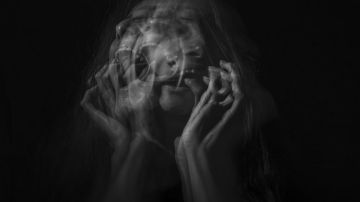Living With Borderline Personality Disorder and How the ‘Crazy Latina’ Trope Has Harmed Me
I was ten years old

Photo: Unsplash/@quinterocamilaa
I was ten years old. I couldn’t sleep. My sexual abuser slept in the room adjacent to mine. He violently kicked and threw punches in his sleep. I sat at the top of the stairs and said to myself: “I don’t care if he dies. I’ll only cry because mami will be sad that her father is dead.” Seeds of hatred from his abuse had already sprouted resentment and anger inside my small body.
The next day, I resumed a caretaker role. A few months prior, he had fallen down a flight of stairs as I followed behind him. I witnessed him lying motionless in his own blood. Consequently, he required assistance throughout the day as he recovered. This was one of several times I played nurse for someone who had abused me. As a Latina, I was taught to fulfill jobs for my family before I was even legally of age to hold a job. As a result, I internalized a toxic self-image contingent upon how useful I was to others. On the rare occasion that I did voice my stress or fatigue, my sincerity was questioned: “How can you be stressed? You don’t pay any bills around here.”
Growing up in an emotionally-invalidating environment lays the foundation for developing borderline personality disorder (BPD): a condition characterized by unstable behaviors, moods, and relationships. Mentally flipping through a rolodex of childhood memories, I notice many instances of being called una chola, una loca, and a bitch by family members. At school, some teachers and classmates accused me of being aggressive or having an attitude despite my overt shyness. Sadly, I recall very few instances of being asked about my feelings.
After receiving my BPD diagnosis as an adult, I felt that all the putdowns from my childhood were true. I thought of Angelina Jolie’s borderline character in Girl, Interrupted and could not identify with her behaviors. Eventually, I learned that those living with BPD exist on a spectrum. Although I wasn’t like Jolie’s character, my identity disruption, black-and-white thinking, my fight-or-fight-harder response, and my self-destructive behaviors were undeniable symptoms of living with BPD.
As a Latina, my identity is constantly bombarded by outside messages; Hollywood labels us as “firecrackers,” romantic partners are curious if the “crazy Latina girlfriend” is accurate, and society expects all Latinas to be “feisty.” Whether you’re turned on by us or fear us, you are not hearing or seeing us. Our mental health is neither a fetish nor a running joke. Personally, these outside messages only exacerbate the identity disruption I experience as part of my BPD.
Too often, society dismisses the feelings of “crazy Latinas” as exaggerated reactions and hostility. In reality, Latinas are coping with elevated rates of domestic violence, unresolved traumas, and chronic illness. For instance, studies show that 75% of those diagnosed with BPD are women and those that have experienced childhood trauma are 13 times more likely to be diagnosed. Accordingly, Latinas are prime candidates for BPD because we have an epidemic-level suicide rate and four out of five Latino youth have experienced at least one childhood trauma.
Latinas continue to face many barriers to mental health treatment. For instance, cultural norms discourage Latinx from seeking mental health treatment. Overall, less than one in 11 Latinx living with a mental disorder will contact a mental health specialist. Of those that seek counseling, most will deal with racially-biased services because 84% of mental health practitioners are white. Frequently, societal stereotypes paint Latina mental health as a cultural flaw instead of an actual health issue. In today’s America, a Latina that has experienced sexual abuse is more likely to sit behind bars than in front of a therapist. Unfortunately, 80 percent of incarcerated girls in the juvenile system are survivors of sexual abuse and the majority are girls of color.
The “crazy Latina” trope that is popularized by the media and accepted by society is an erasure of Latina mental health. The truth is Latinas are experiencing a mental health crisis. This stereotype, as well as cultural taboos against mental health treatment, personally hurt my emotional development and access to appropriate therapy for BPD. I know I am not the only one. It is necessary for greater society to recognize this stereotype as a racist and sexist force against Latinas. Instead of vilifying Latinas, media programs and community members should focus on ending the gap in mental health care access for Latinas. At a minimum, they can start by validating the very real experiences and feelings of Latinas.

















